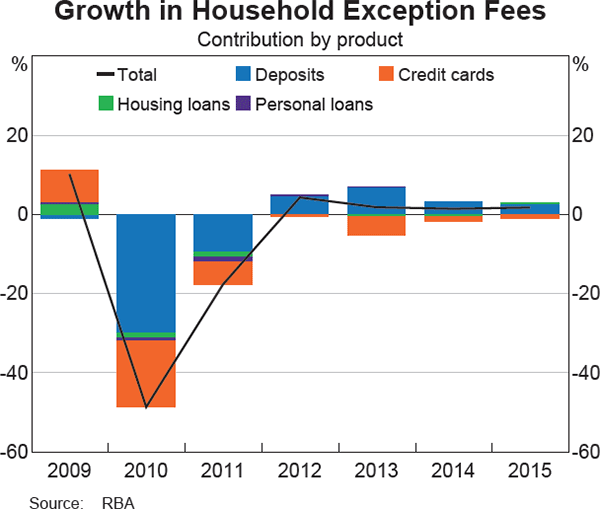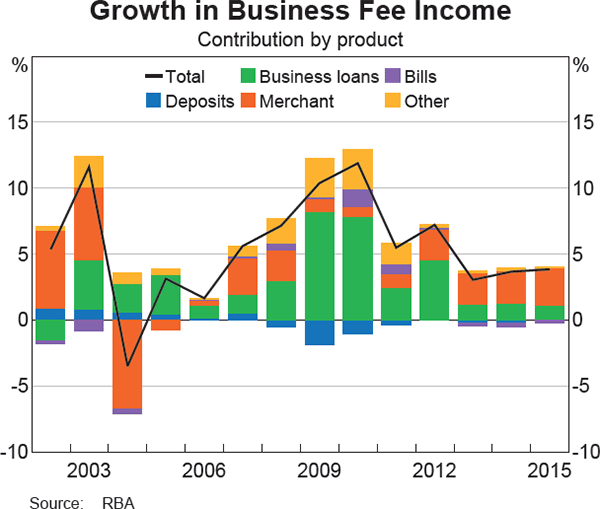Bulletin – June 2016 Payments Banking Fees in Australia
- Download the article 262KB
Abstract
The Reserve Bank has conducted a survey on bank fees each year since 1997. The results of the most recent survey suggest that banks' fee income from both households and businesses rose in 2015, due to a combination of balance sheet growth and higher unit fees on some products. Deposit and loan fees have continued to decline as a ratio to the outstanding value of deposits and assets, respectively.
Overview
The Reserve Bank's annual survey of bank fees provides information on the fees earned by banks through their Australian operations.[1] The focus of the survey is on fee income generated through the provision of loans, deposit services and payment services. The 2015 survey included 16 institutions, capturing over 90 per cent of the Australian banking sector by balance sheet size.[2] Fees earned from operations outside of Australia and other fee income obtained through funds management and insurance operations are excluded from the survey. This article summarises the results from the latest survey, covering banks' financial years ending in 2015.[3]
In 2015, domestic banking fee income grew by 3.5 per cent, to around $12.5 billion (Table 1). This reflected moderate increases in fees paid by both households and businesses, driven by a combination of volume growth and increases in some unit fees. Deposit and loan fees as a ratio to the outstanding value of deposits and assets, respectively, were slightly lower than in the previous year (Graph 1).

| Households | Businesses | Total | ||||
|---|---|---|---|---|---|---|
| Level | Growth | Level | Growth | Level | Growth | |
| $ million | Per cent | $ million | Per cent | $ million | Per cent | |
| 2012 | 4,054 | −0.7 | 7,368 | 7.2 | 11,421 | 4.3 |
| 2013 | 4,118 | 1.6 | 7,593 | 3.1 | 11,711 | 2.5 |
| 2014 | 4,206 | 2.2 | 7,872 | 3.7 | 12,079 | 3.1 |
| 2015 | 4,328 | 2.9 | 8,176 | 3.9 | 12,504 | 3.5 |
|
Source: RBA |
||||||
Households
Banks' fee income from households grew by 2.9 per cent in 2015, the third consecutive year of positive growth (Table 2). Higher fee income largely reflected growth in fee income from credit cards, which grew strongly for the second consecutive year. Growth in housing and personal lending fees was moderate, while fee income from deposit products declined in 2015 (Graph 2).
| 2013 | 2014 | 2015 | Annual growth 2015 | Average annual growth 2007–14 | |
|---|---|---|---|---|---|
| $ million | $ million | $ million | Per cent | Per cent | |
| Loans: | 2,904 | 2,999 | 3,135 | 4.5 | 2.2 |
| – Housing | 1,218 | 1,219 | 1,251 | 2.7 | 1.8 |
| – Personal | 350 | 366 | 376 | 2.7 | 2.2 |
| – Credit Cards | 1,335 | 1,414 | 1,508 | 6.6 | 2.6 |
| Deposits | 1,111 | 1,108 | 1,083 | −2.3 | −7.8 |
| Other fees | 103 | 100 | 111 | 11.3 | 1.9 |
| Total | 4,118 | 4,206 | 4,328 | 2.9 | −1.3 |
|
Source: RBA |
|||||
Fee income from credit cards, the largest single source of fee income from households, increased strongly in 2015. The increase in fee income from credit cards was due to both more instances of fees being charged and an increase in unit fees on some products. An increase in currency conversion fees incurred by households for overseas purchases was largely a result of an increase in the number of foreign currency transactions, with only a small increase in average unit fees (Table 3). Banks increased some unit fees during 2015, in particular those relating to credit card annual fees and cash advances. Several banks also increased fee income from credit cards through the acquisition of existing credit cards from other providers. Some improvements to participants' reporting methodologies also resulted in the inclusion of some credit card fee income that was previously being excluded from the RBA's survey.

Income from exception fees charged to households on credit card products continued to decline in 2015 (Graph 3). This was the result of customers reducing the number of instances in which they exceeded their credit card limits or made late payments.
The main drivers of modest growth in fee income on personal lending were higher unit fees and increased turnover. Some banks also increased lending volumes, resulting in higher establishment and loan registration fee income.[4] Income from exception fees and transaction fees on personal lending declined.

Growth in fee income from housing loans was consistent with housing credit growth during 2015. Higher fee income was due to a higher volume of new loans, more instances of early repayment fees and, to some extent, higher unit fees on home loan packages. The major banks and large regional banks recorded the highest growth in housing loan fee income, while some smaller regional banks reported declines in fee income as a result of lower volumes of loans.
| 2013 | 2014 | 2015 | Annual growth 2015 | |
|---|---|---|---|---|
| Per cent | ||||
| Annual fees ($) | ||||
| Non-rewards cards | 61 | 51 | 53 | 4.7 |
| Rewards cards | 170 | 186 | 185 | −0.5 |
| All cards | 127 | 134 | 133 | −1.1 |
| Other fees | ||||
| Foreign currency conversion fees (per cent of value) |
2.8 | 2.9 | 2.9 | 0.3 |
| Late payment fee ($) | 19 | 19 | 17 | −8.4 |
|
(a) Simple average fees for cards issued by a sample of seven banks; only cards that are available to new cardholders are included in the sample; note that changes in the sample affect the average fee; as at June of each year Sources: Credit card issuers' websites; RBA |
||||
Fee income from deposit accounts declined further over 2015. The decline in fee income was broad based across most types of deposit fees, but there were notable declines in fee income relating to non-transaction accounts such as term deposits and online savings accounts. The introduction of notice periods for ‘breaks’ on term deposit contracts has resulted in fewer instances of these fees; where customers were previously charged a fee for breaking the duration of their term deposit, 31-day notice periods for withdrawals have resulted in fewer banks charging these fees. In addition, customers have shifted towards deposit products with lower fees, such as online savings accounts. Higher use of contactless payments facilities and decreased use of cash has also led to fewer ATM withdrawals and therefore fewer charges. Some banks lowered their unit fees on international withdrawals from deposit accounts, resulting in declines in fee income from this activity. Somewhat offsetting these declines, income from other fees (such as currency conversion fees) and exception fees on deposit accounts increased (Graph 3).
Businesses
Total fee income from businesses increased by 3.9 per cent, primarily reflecting higher fee income from small businesses (Graph 4; Table 4). By product, growth in fee income from businesses continued to be driven by merchant fees and business loans (Graph 5). Fee income from bank bills declined sharply in 2015, similar to previous years. Fee income from other business products was little changed.
The increase in loan fee income was mainly due to increases in unit fees for small business loans, although lending volumes also increased. Loan fee income from large businesses declined over 2015 as several banks lowered their unit fees due to increased competitive pressures.


Growth in merchant fee income over 2015 was evenly spread across small and large businesses. The increase in income from merchant fees was largely a result of growth in the number and value of transactions, resulting from a higher number of merchant terminals on issue and increased use of contactless payments. This partially offset a decline in fees earned on cash payment services, via ATM and deposit account withdrawals. A few banks also increased unit fees on merchant services, although the ratio of merchant fee income to the value of credit and debit card transactions continued to decline during 2015 (Graph 6).
| 2013 | 2014 | 2015 | Annual growth 2015 | Average annual growth 2007–14 | |
|---|---|---|---|---|---|
| $ million | $ million | $ million | Per cent | Per cent | |
| Deposit accounts | 606 | 589 | 587 | −0.3 | −4.9 |
| – of which: exception fees | 41 | 41 | 41 | −1.8 | −8.4 |
| Loans | 3,276 | 3,372 | 3,460 | 2.6 | 10.5 |
| – of which: exception fees | 39 | 42 | 42 | 0.8 | 0.1 |
| Merchant service fees | 2,241 | 2,427 | 2,651 | 9.2 | 5.8 |
| Bank Bills | 226 | 204 | 190 | −7.1 | 16.6 |
| Other | 1,258 | 1,280 | 1,287 | 0.6 | 8.7 |
| Total | 7,593 | 7,872 | 8,176 | 3.9 | 6.9 |
| – of which: exception fees | 81 | 83 | 83 | −0.5 | −4.9 |
|
Source: RBA |
|||||

Somewhat offsetting growth in merchant and loan fee income, bank bill fee income declined over 2015. This reflects a broader shift away from the use of bank bills and encouragement from banks for customers to shift to alternate products.
Fee income from business deposit products also declined slightly. This was mainly due to a reduction in deposits held by these customers; however, the decline in fee income was also the result of customer switching between deposit accounts in order to make use of lower fee products.
Footnotes
The author is from Domestic Markets Department. [*]
The data from the survey are published in the Reserve Bank's Statistical Table C9, ‘Domestic Banking Fee Income’, and are subject to revision on the advice of participating banks. [1]
Survey results have been affected by mergers and acquisitions among participating institutions and some changes in participants' methodology (wherever possible, this has been reflected in revisions to data reported in previous years). [2]
Apart from Table 3, all data from the survey are based on individual banks' financial years, which differ between banks. [3]
Fee income from personal loans was also affected by improvements to participants' reporting methodologies, resulting in higher fee income in 2015 being reported from this category than would have otherwise been the case. [4]